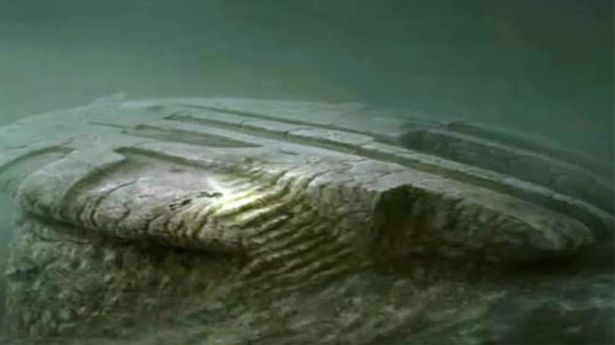Explorers discovered an unknown structure at the bottom of the sea between Sweden and Finland. It has proved to be an 11-year-old mystery, with theories as wild as it being a crashed UFO doing the rounds

Image: Youtube)
A UFO? A forgotten Nazi bunker? An underwater Stonehenge?
All of these theories have been used to describe the mystery formation that is the Baltic Sea Anomaly.
Deep under the waves, marine explorers found an unidentified mound in the sea between Sweden and Finland.
The Ocean Explorer team discovered the formation in June 2011 during an eventful exploration.
Sonar images returned and confronted them with a sight they had not expected.
Bedtime Stories YouTube channel, in its video describing the discovery of the Anomaly, said: “There were clear lines and striations across its surface which almost seemed to resemble the layout of corridors and rooms.
(
Image:
sonofmabarker)
“And behind it, a 1000-foot long ‘runway’ had been flattened in the sand, seeming to indicate that the object had slid down to the point where it now rested.”
Divers from the crew, sent down to take a closer look, would find what resembled a series of steps and a domed compartment jutting out from the main body of the structure.
It appeared to the divers that there could be tunnels or passageways beneath the surface of the unknown object.
What they say happened next has continued to puzzle those looking to answer the mystery of the Baltic Sea Anomaly.
When the Ocean X ship looked to take some high-quality images of what was on the seabed, the team ran into difficulties.
Their sensor and photographic equipment failed on them when they were above the mound below.
Sonar was blocked by mysterious electrical interference and satellite phones had their batteries emptied despite having been only recently charged.
All this would fuel talk that what they had uncovered was extra-terrestrial, with the domed structure argued to possibly be a cockpit of a flying saucer.
(
Image:
Google Maps)
Some reckon the Anomaly looks like the famed Millennium Falcon ship from Star Wars.
However, Simon Andrews, who wrote the 19-minute Anomaly piece for Bedtime Stories, said the suggestion that an alien spaceship had been discovered seemed wide of the mark.
Studies of the material investigated by Stockholm University showed the material the structure was made up of was volcanic rock.
As Mr Andrews states, it seems highly unlikely a life form from outer space built a ship from stone — and from mineral materials commonly found on earth.
But that is not to say that outlandish theories are not still out there.
The fact that electrical equipment was frazzled when deployed above the mound has led some to speculate whether it could have been a secret Nazi bunker.
Mr Andrews said some had pushed the Anomaly as a secret military project by Adolf Hitler’s Third Reich forces during World War II.
(
Image:
Youtube)
Proponents of the theory say it could have been lowered into the sea, designed as an anti-shipping weapon in the Bolthian Sea in the battle for Scandinavia.
Less far-fetched is the idea that it could be an ancient temple or a now-submerged Stonehenge related to a real-life Atlantis — a city now claimed by the sea.
That hypothesis is not as out-there as it might seem.
Britain was once connected to mainland Europe via an area now called Doggerland, but it was lost when flooded by rising sea levels in 6,500-6,200 BC.
Away from the left-field theories, scientists think they have the answer to what the underwater formation is.
Geologists have concluded that the Baltic Sea Anomaly is leftovers from moving glaciers during the Ice Age, which carved out much of the Baltic Sea.
In essence, the Anomaly is nothing more than a glacial deposit.
Volker Brüchert, an associate professor of geology at Stockholm University, said: “I was surprised when I researched the material I found a great black stone that could be a volcanic rock.”
He added: “My hypothesis is that this object, this structure was formed during the Ice Age many thousands of years ago.
“Because the whole northern Baltic region is so heavily influenced by glacial thawing processes, both the feature and the rock samples are likely to have formed in connection with glacial and postglacial processes.
“Possibly these rocks were transported there by glaciers.”
Göran Ekberg, a marine archaeologist at Maritime Museum in Stockholm, said: “A natural, geological formation can’t be ruled out.
“I agree the finding looks weird since it’s completely circular. But nature has produced stranger things than that.”
But the crew behind the discovery has refused to accept what could be seen as a mundane conclusion compared to the other concepts batted around.
Stefan Hogerborn, a member of Ocean X, reiterated that the crew’s electrical equipment stopped working when they got to within 200 metres of the anomaly on the Baltic seabed.
He suggested that was not something that could have been caused by a volcanic rock formation.
“Anything electric out there – and the satellite phone as well – stopped working when we were above the object,” he told India’s New Delhi TV (NDTV).
“And then we got away about 200 metres and it turned on again, and when we got back over the object it didn’t work.”
Read More
Read More
Read More
Read More
Hits: 7










